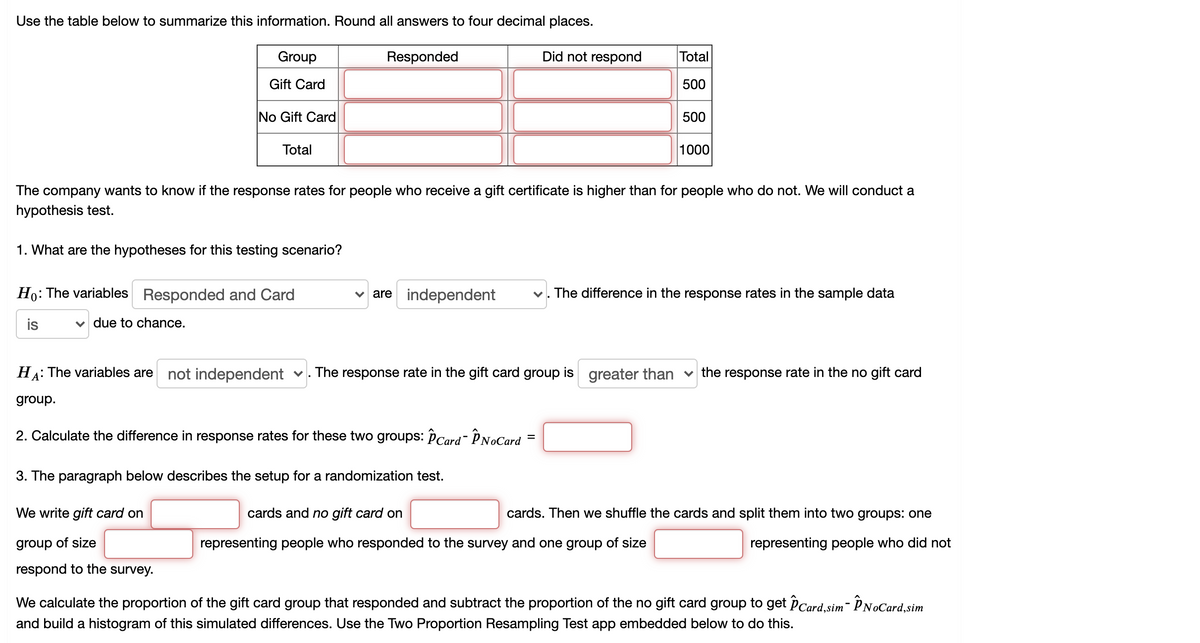A 20-minute consumer survey mailed to 500 adults aged 25-34 included a $5 Starbucks gift certificate. The same survey was mailed to 500 adults aged 25-34 without the gift certificate. There were 73 responses from the first group and 42 from the second group.
A 20-minute consumer survey mailed to 500 adults aged 25-34 included a $5 Starbucks gift certificate. The same survey was mailed to 500 adults aged 25-34 without the gift certificate. There were 73 responses from the first group and 42 from the second group.
Glencoe Algebra 1, Student Edition, 9780079039897, 0079039898, 2018
18th Edition
ISBN:9780079039897
Author:Carter
Publisher:Carter
Chapter10: Statistics
Section10.1: Measures Of Center
Problem 9PPS
Related questions
Question
100%
A 20-minute consumer survey mailed to 500 adults aged 25-34 included a $5 Starbucks gift certificate. The same survey was mailed to 500 adults aged 25-34 without the gift certificate. There were 73 responses from the first group and 42 from the second group.

Transcribed Image Text:Use the table below to summarize this information. Round all answers to four decimal places.
Group
Responded
Did not respond
Total
Gift Card
500
No Gift Card
500
Total
1000
The company wants to know if the response rates for people who receive a gift certificate is higher than for people who do not. We will conduct a
hypothesis test.
1. What are the hypotheses for this testing scenario?
Ho: The variables Responded and Card
are independent
v. The difference in the response rates in the sample data
is
due to chance.
HA: The variables are not independent v. The response rate in the gift card group is greater than v the response rate in the no gift card
group.
2. Calculate the difference in response rates for these two groups: PCard- PNoCard =
3. The paragraph below describes the setup for a randomization test.
We write gift card on
cards and no gift card on
cards. Then we shuffle the cards and split them into two groups: one
group of size
representing people who responded to the survey and one group of size
representing people who did not
respond to the survey.
We calculate the proportion of the gift card group that responded and subtract the proportion of the no gift card group to get PCard,sim- PNoCard,sim
and build a histogram of this simulated differences. Use the Two Proportion Resampling Test app embedded below to do this.
Expert Solution
This question has been solved!
Explore an expertly crafted, step-by-step solution for a thorough understanding of key concepts.
This is a popular solution!
Trending now
This is a popular solution!
Step by step
Solved in 2 steps with 2 images

Knowledge Booster
Learn more about
Need a deep-dive on the concept behind this application? Look no further. Learn more about this topic, statistics and related others by exploring similar questions and additional content below.Recommended textbooks for you

Glencoe Algebra 1, Student Edition, 9780079039897…
Algebra
ISBN:
9780079039897
Author:
Carter
Publisher:
McGraw Hill

Glencoe Algebra 1, Student Edition, 9780079039897…
Algebra
ISBN:
9780079039897
Author:
Carter
Publisher:
McGraw Hill